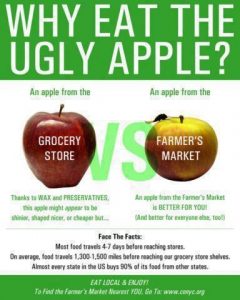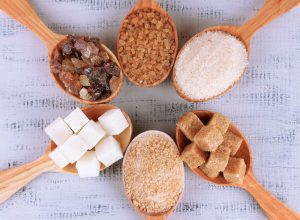Did you know that globally 1-2 billion tons of food produced from farmers goes to waste every year? It’s a scary figure when you think of the 850 million people around the world that are becoming ill or even dying from starvation. So you might be asking yourself, how is this even possible? Why is food being wasted and yet, millions are starving across the world? I’m glad you asked. It goes back to consumer demands and the all mighty dollar. The agriculture business, more specifically the industrialized farming industry is in it to make money at any cost. In order to produce the most food possible for the least amount of money they create: pollution of the air, surface water, and groundwater; over-consumption of fossil fuel and water resources; degradation of soil quality, erosion, and accelerate the loss of biodiversity through mono-cropping.
Mono-cropping is where a region will specialize in producing one to a half dozen of varieties of one species like bananas, or tomatoes, etc. Even though there are thousands of varieties of tomatoes from white to yellow to purple to pink, Heinz the monopolist of the tomato industry only grows 2 varieties, because they grow a large red round shape, resist disease and ship well. In the US alone, 96% of the tomatoes grown come from California, even though all 50 states can grow tomatoes and did 50 years ago.
So why does this matter? This becomes an issue for consumers because insects and disease also like to eat the crops. So in order to keep the crops from being eaten, farmers must use pesticides, which work most of the time. However, sometimes a disease can wipe out acres of a species. This can destroy the livelihood of the local farmers. Centuries ago, this common farmer problem was combated by planting various acres of all types of crops (diversifying), so that if there was an insect or disease, it would only wipe out a small portion of the farmers crops for the year. This also allowed for consumers to get a variety of produce in their same community, often times growing food themselves or trading with their neighbors.
What this did was create a variety of foods with very little expectations on size and taste. As the agriculture industry shifted to producing predominately wheat, soy, and corn products, consumers were forced to start shopping at the local grocery store for all their produce and at some point became conditioned to expect a certain color or shape from our produce in the grocery store. As such, farmers are now required to have their produce look a certain way in order to be accepted by the large grocery store chains. So the produce that doesn’t make the cut is left to rout. In addition, the grocery store will typically overstock food items, and are forced to dispose of food that spoils after several days on the shelf. This is one way in which we waste tons of food every year.
So what small change can we do as consumers to change the way our farmers supply our fruits and vegetables? By making a choice to purchase our produce from local farmers we are sending a message that we support the companies that are doing their best to diversify, protect the environment, and support the local economy (tax revenue). In doing so, we not only support the farmers that are using a variety of crop species (some you may never see in your local grocery store) we are also reducing the gas emissions from transporting the foods across the world.
I compiled a list of the top five benefits of buying from our local farmers:
1) Tastes Better. Produce is picked at its peak only days before you bring it home. However, store bought produce is picked 4-7 days before it arrives in the supermarket. The produce is intentionally picked before it becomes ripe to preserve its shelf life making it taste less sweet and less flavorful.
2) Is Better For You. Fresh produce loses their nutrients fairly quickly the longer they are on the shelf. By buying directly from the farmer you are going to retain more nutrients. Also most local farmers practice crop rotation to help preserve the soil and its nutrients. Many local farmers do not use GMOs or pesticides in growing their crops.
3) Preserves Genetic Diversity. In our current agricultural system, plant varieties are chosen for their ability to ripen uniformly, withstand harvesting, survive packing and last a long time on the shelf. There is limited genetic diversity in large-scale production. Smaller local farms, in contrast, often grow many different varieties of crops to provide a long harvest season, an array of colors, and the best flavors.
4) Reduce Emissions. Most produce in The US is transported an average of 1500 miles before being sold. Think about how much oil is used to get the bananas from Brazil. We can all do our part to reduce oil used every year, and this is just one way.
5) Investing in the Future. If our agriculture continues to go down the road it has over the past 50 years, the future of our food quality is at risk. We have lost so many different plant species from mono-cropping, important minerals from our soil from over producing, our limited petroleum sources from over reliance on it for mass production and distribution; it is only a matter of time before this system fails. We can help prevent this from happening by buying our food locally.
How to buy locally:
1) Go to your local farmers market. The local farmers will typically have a stand every week, so you can talk directly with the person that grows the food.
2) Join a Community Supported Agriculture (CSA) program. Local farms or a middle man will deliver local boxes of a variety of fruits and vegetables to your home or office. Here you often do not get to decide what you receive but it is much more convenient than going to a designated farmers’ market location.
3) Other direct to consumer programs like farms stands, and pick-your-own harvests.
As consumers we have the power to change the way we get food on our plates. We have the power to make our voices heard by putting our money towards programs that are invested in making the future for the people and our planet better. Think of it this way, only 18 cents of every dollar, when buying at a large supermarket, goes to the grower. 82 cents go to various unnecessary middlemen. Cut them out of the picture and buy your food directly from your local farmer.









